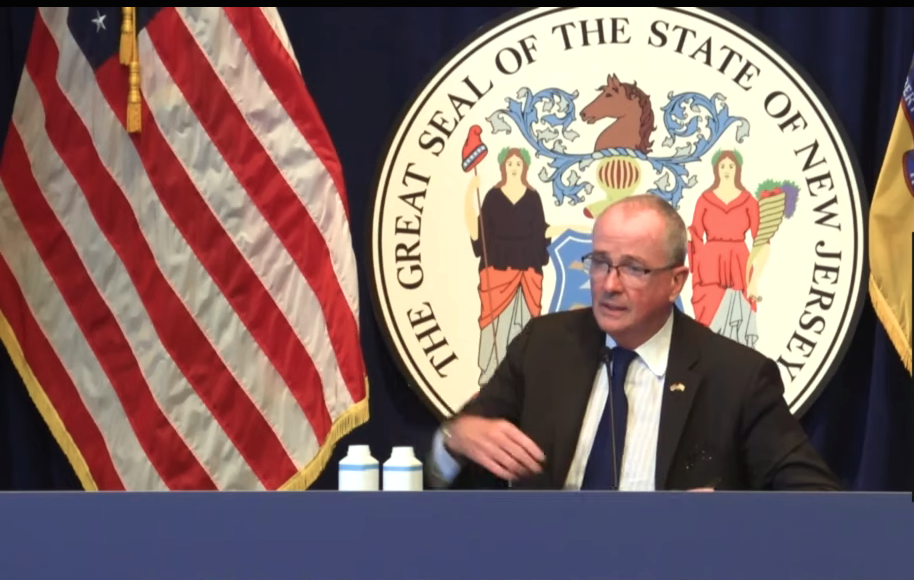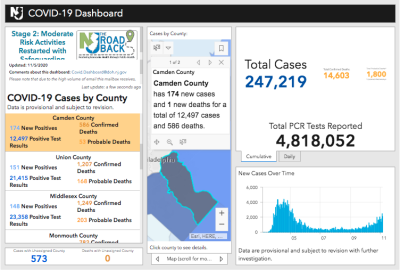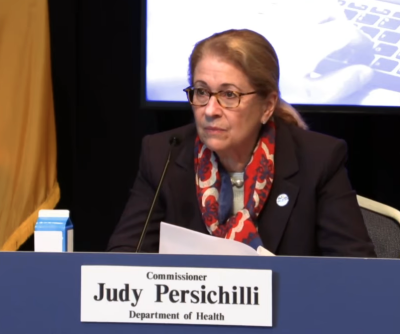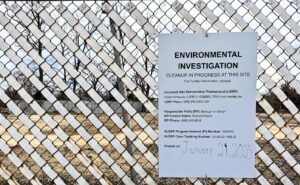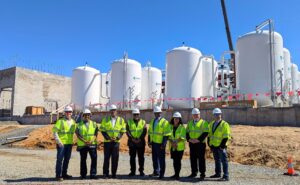Although the governor praised the work of ‘hot spot’ teams in targeted interventions against the virus, he suggested that further interventions could be forthcoming if conditions don’t improve across the state.
By Matt Skoufalos | November 5, 2020
Another 2,104 New Jersey residents have tested positive for novel coronavirus (COVID-19), bringing the statewide total to 247,219 cases, Governor Phil Murphy reported Thursday.
In the past three days alone, the state has recorded 6,408 new infections.
Sadly, 12 more residents have perished from complications related to the virus, bringing the statewide death toll to 14,603 lives lost during the pandemic.
In addition to those lab-confirmed fatalities, the state has acknowledged another 1,800 probable COVID-19-related deaths.
Since March, 433 of every 100,000 New Jersey residents have been hospitalized with COVID-19, and 166 of every 100,000 have died from COVID-19-related complications.
More than 4.81 million polymerase chain reaction (PCR) tests for COVID-19 have been performed statewide, with a 2.81-percent positivity rate per 100,000 residents.
Rate of transmission (Rt) at 1.26, spot positivity lowest in South Jersey
The statewide average of COVID-19 spot positivity testing stood at 7.74 percent November 1; in South Jersey, it was lowest, at 6.47 percent.
Rt, the variable that describes the seven-day, rolling-average rate of transmission of new COVID-19 cases, hit 1.26 from samples taken November 3.
An Rt figure greater than 1.0 means that each new COVID-19 patient is infecting more than one other person, on average, and the spread of the virus is increasing.
Since its mid-April COVID-19 spike, the highest reported RT in New Jersey was 1.48, recorded August 1. The lowest was 0.62, recorded June 9.
Hospitalizations tripled since August levels, Camden County leads state in school-based infections
Throughout New Jersey, 1,224 people currently are hospitalized with a suspected case of COVID-19. That’s three times the figures last seen in August, New Jersey Health Commissioner Judy Persichilli said.
Among those hospitalized patients, 238 are in intensive or critical care, and 68 of the ICU and critical-care patients (36 percent) are on ventilators.
Across the state, 840 long-term care (LTC) centers have reported at least one case of COVID-19, and 191 are dealing with an active outbreak. LTCs account for 39,999 infected patients and staff in New Jersey, or 16 percent of total cases.
That includes 25,721 residents and 14,278 staffers sickened by the virus, as well as 7,232 lab-confirmed resident and staff deaths (50 percent of the statewide total), with facilities self-reporting 121 staff deaths.
Of 656 veterans residing in a state-run home, 396 residents have tested positive for COVID-19, and 146 have died from complications related to the virus. Ten veterans presently are hospitalized with COVID-19, and 248 have recovered from the virus.
At state-run psychiatric facilities, 229 of 1,175 patients and 538 staff members have tested positive for COVID-19. Thirteen patients and seven staffers have died from complications related to the virus.
To date, 61 New Jersey children aged 1 to 18 have been diagnosed with pediatric multisystem inflammatory syndrome, Persichilli said.
All those pediatric patients have tested positive for an active COVID-19 infection or the presence of COVID-19 antibodies, indicating exposure to the virus. No deaths have been associated with this syndrome in New Jersey, although several children have been hospitalized during their treatment.
Since August 1, 36 COVID-19 outbreaks encompassing 146 individual cases have been traced to schools in 15 New Jersey counties. In Camden County, six outbreaks have been linked to 45 cases. That’s the most in the state.
Surge attributed to small, in-home gatherings, Murphy content to stick to ‘hot-spot teams’ for now
As COVID-related hospitalizations and new reports of infections surge, Persichilli urged residents to push back against pandemic fatigue.
“Even when we are with our loved ones and friends, we need to mask up,” she said.
“While we are seeing cases related to activities such as sports, or school, or daycare, and workplaces, the majority of our cases are not easily traced back to a single exposure, and are likely related to routine gatherings in places such as your homes,” Persichilli said.
While touting the success of targeted interventions from the state, county, and urban health department “hot spot” intervention teams, the governor said his administration “will clearly be taking action” to get the numbers of new cases down.
“How close are we to doing something?” Murphy said. “Close. So bear with us.”
“I hope it will be action that balances the various challenges and interests that we have,” he said, “but right now, we’ve had really good success, and Judy’s led it, with the hotspot teams. It’s working. We’re deploying testing, tracing, enforcement, the whole shooting match, but we’re looking at a number of different steps that we could take.”
Murphy concluded his remarks Thursday with a familiar plea: “Folks, please fight through that fatigue.”
Unemployment update
Last week, roughly 24,700 New Jersey workers submitted an initial claim for unemployment benefits, down 2,500 from week-ago numbers, and a third consecutive week of declines, the governor said Thursday.
Since March, 1.7 million New Jerseyans have filed a claim for benefits, and 1.46 million, or 96 percent, have received them. More than $18.4 billion in benefits has been paid out thus far.

